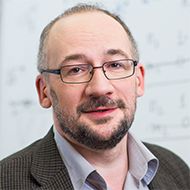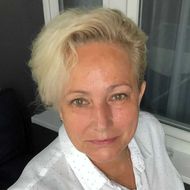- A
- A
- A
- АБB
- АБB
- АБB
- А
- А
- А
- А
- А
- Национальный исследовательский университет «Высшая школа экономики»
- Факультеты
- Факультет компьютерных наук
- Департамент анализа данных и искусственного интеллекта
- Новости
- Лекции профессора Штефана Шмита по алгебраическому анализу данных
-
Департамент
Адрес: 109028, г. Москва, Покровский бульвар, д. 11, корпус S, комната S938 (станции метро "Чистые пруды" и "Курская").
Телефон: +7(495) 772-95-90 *27319
Департамент анализа данных и искусственного интеллекта был создан в 2014 году на базе кафедры анализа данных и искусственного интеллекта. В его состав входят исследователи с мировым именем, активно участвующие в международных исследовательских проектах.
Acquaye F. L., Kertesz-Farkas A., Stafford Noble W.
Journal of Proteome Research. 2023. Vol. 22. No. 2. P. 577-584.
Vasilii A. Gromov, Yury N. Beschastnov, Korney K. Tomashchuk.
PeerJ Computer Science. 2023. Vol. 9. No. .
Kanovich M., Kuznetsov S., Scedrov A.
Information and Computation. 2022. Vol. 287.
Egurnov D., Ignatov D. I.
Automation and Remote Control. 2022. Vol. 83. No. 6. P. 894-902.
Egurnov D., Точилкин Д. С., Ignatov D. I.
In bk.: Complex Data Analytics with Formal Concept Analysis. Springer, 2022. P. 239-258.
Dudyrev F., Neznanov A., Anisimova K.
In bk.: Artificial Intelligence in Education. Posters and Late Breaking Results, Workshops and Tutorials, Industry and Innovation Tracks, Practitioners’ and Doctoral Consortium -23rd International Conference, AIED 2022, Durham, UK, July 27–31, 2022, Proceedings, Part II. Springer, 2022. P. 436-439.
Zhirayr Hayrapetyan, Nascimento S., Trevor F. et al.
In bk.: Information Systems and Technologies: WorldCIST 2022, Volume 2. Iss. 469. Springer, 2022. P. 141-147.
Dudyrev E., Semenkov Ilia, Kuznetsov S. et al.
Plos One. 2022. Vol. 17. No. 10.

Лекции профессора Штефана Шмита по алгебраическому анализу данных
Speakers: Stefan E. Schmidt and Franziska Leonhardi
Title: Musicà MathàArtsàMusicà
Speaker: Stefan E. Schmidt and Franziska Leonhardi
Title: Musicà MathàArtsàMusicà
Abstract: Among those pioneering mathematicians who shed some light on the world of music theory, we want to mention Pythagoras and Leonhard Euler, and more contemporary, Rudolf Wille and Guerino Mazzola. Their common objective was the description of phenomena of music via mathematical means, that is, they came up with a mathematical modeling of music theory. While Pythagoras and Euler developed a theory of proportions and harmony, Wille and Mazzola sketched out a set-theoretic approach which is closely related to category theory. A systematic description of tone, chroma, and interval is given in Wille’s and Neumeier’s “extensional standard language” for music theory; also concepts like sound (pattern) and harmony (pattern) are strictly defined in a formal mathematical fashion, which contrasts the more ambiguous use in classical music theory.
The fundamental modeling idea is a psychoacoustic one, which is not primarily based on physics. For example, a fifth plus a fourth is an octave, while in physics the proportion of the fifth multiplied by the proportion of the fourth is the proportion of an octave, that is, (3:2)x(4:3)=1:2.
Our presentation will differ from a usual lecture style since we aim to combine a traditional mathematical modeling approach with semiotics using graph theory and category theory. This will lead us to the fundamental notion of a tone structure where a covariant functor transforms syntactical intervals into semantic ones. Our considerations will be put into the framework of a general theory of measurement.
In a second part, we will connect the previous with arts. In particular, we will discuss how one may be able to see music. Can mathematics help to give people some good visual experience of music? What can we say about relationships between mathematics, arts and music involving sign language? We will present how collaboration with the artist Franziska Leonhardi in a project www.paulus2011.de has raised questions about the visualization of music using fine arts and mathematics. Can the oratorio of Mendelssohn Bartholdy be experienced by deaf people?
The mathematical language involving semiotics will be confronted with semiotics used in arts of different cultures around the world. Our presentation itself should be considered as a contribution which aims to experience mathematics within a greater cultural context.
Everyone is cordially invited to the interdisciplinary lecture jointly given by the mathematician and musician Prof. Dr. Stefan E. Schmidt, Dresden University of Technology, and by Franziska Leonhardi, artist for painting/graphic/other visual media www.franziska-leonhardi.de.
- О ВЫШКЕ
- Цифры и факты
- Руководство и структура
- Устойчивое развитие в НИУ ВШЭ
- Преподаватели и сотрудники
- Корпуса и общежития
- Закупки
- Обращения граждан в НИУ ВШЭ
- Фонд целевого капитала
- Противодействие коррупции
- Сведения о доходах, расходах, об имуществе и обязательствах имущественного характера
- Сведения об образовательной организации
- Людям с ограниченными возможностями здоровья
- Единая платежная страница
- Работа в Вышке
- ОБРАЗОВАНИЕ
- Лицей
- Довузовская подготовка
- Олимпиады
- Прием в бакалавриат
- Вышка+
- Прием в магистратуру
- Аспирантура
- Дополнительное образование
- Центр развития карьеры
- Бизнес-инкубатор ВШЭ
- Образовательные партнерства
- Обратная связь и взаимодействие с получателями услуг
-
http://www.minobrnauki.gov.ru/
Министерство науки и высшего образования РФ
-
https://edu.gov.ru/
Министерство просвещения РФ
-
http://www.edu.ru
Федеральный портал «Российское образование»
-
https://elearning.hse.ru/mooc
Массовые открытые онлайн-курсы
- © НИУ ВШЭ 1993–2025 Адреса и контакты Условия использования материалов Политика конфиденциальности Карта сайта
- Редактору


